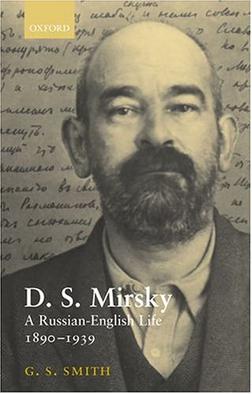D. S. Mirsky facts for kids
D. S. Mirsky was the English pen-name of Dmitry Petrovich Svyatopolk-Mirsky. He was also known as Prince Mirsky. Born in Russia in 1890, he became a well-known historian of politics and literature. He helped people in Britain learn more about Russian literature by promoting its translation. He also helped people in the Soviet Union learn about English literature. He was born in what is now Ukraine and sadly died in a Soviet labor camp in 1939.
Contents
Early Life
Dmitry Petrovich Svyatopolk-Mirsky was born into a noble family. His father, Pyotr Dmitrievich Svyatopolk-Mirsky, was a minister in the Russian government. Dmitry gave up his princely title when he was young. As a student, he became very interested in poetry and even started writing his own poems.
World War One
Mirsky served in the Russian army during World War I. He later joined a group called the White movement, which fought against the new Soviet government. He worked on the staff of General Anton Denikin.
Life in London
Mirsky moved to Great Britain in 1921. He taught Russian literature at the University of London. During this time, he wrote an important book called A History of Russian Literature: From Its Beginnings to 1880. Another famous writer, Vladimir Nabokov, said it was the best history of Russian literature ever written. Mirsky then wrote another book, Contemporary Russian Literature, 1881–1925.
Mirsky was also involved in a group called the Eurasia Movement. His political ideas slowly changed, and he became interested in Marxism. In 1931, he joined the Communist Party of Great Britain. He asked a famous Russian writer, Maxim Gorky, to help him get permission to return to the Soviet Union. He was allowed to go back in 1932. When he left, the writer Virginia Woolf wrote in her diary that she worried about his safety.
Return to Russia
Mirsky went back to Russia in September 1932. Five years later, during a period known as the Great Purge, he was arrested. The Great Purge was a time when many people in the Soviet Union were arrested and punished by the government.
Mirsky's arrest might have happened after he met his friend, the British historian E. H. Carr. Carr was visiting the Soviet Union in 1937 and met Mirsky by chance in Leningrad (now Saint Petersburg). Even though Mirsky tried to pretend he didn't know him, Carr convinced him to have lunch. At that time, anyone in the Soviet Union who had contact with a foreigner without permission could be seen as a spy. Because of this, the NKVD (the Soviet secret police) arrested Mirsky, thinking he was a British spy.
He died in a gulag (a forced labor camp) near Magadan in June 1939. He was buried on June 7th. In 1962, he was officially cleared of any wrongdoing, a process called "rehabilitation." Even though his most important work was published in Russia later, he is still not widely known in his home country.
The writer Korney Chukovsky described Mirsky in his diary in 1935:
I really liked him. He had a lot of knowledge, was honest, and was a talented writer. He had a funny beard and bald spot, and his English suit looked old and worn. He would make a sympathetic sound after everything you said. He was very amusing and kind.
Selected Publications
- Anthology of Russian poetry (1924)
- Modern Russian Literature (1925)
- Pushkin (1926)
- A History of Russian Literature: From Its Beginnings to 1900 (in two volumes, 1926, 1927)
- A History of Russia (1928)
- Lenin (1931)
- Russia: A Social History (1931)
- The Intelligentsia of Great Britain (1935)
- Anthology of Modern English Poetry (1937)
Images for kids
-
Mirsky after his arrest in 1937
See also
 In Spanish: Dmitri Mirski para niños
In Spanish: Dmitri Mirski para niños



